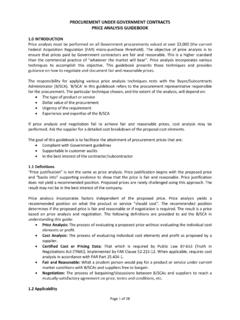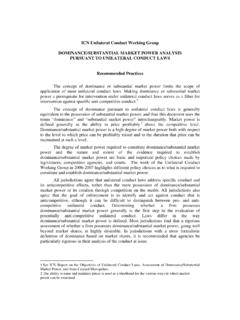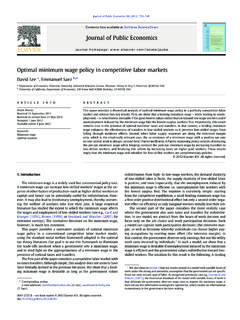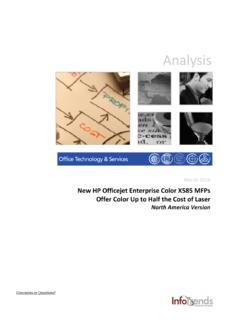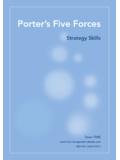Transcription of Psychological Pressure in Competitive …
1 Psychological Pressure in CompetitiveEnvironments: evidence from a RandomizedNatural ExperimentJose Apesteguia Ignacio Palacios-Huerta Forthcoming in theAmerican Economic ReviewSeptember 2009 AbstractEmotions can have major e ects on performance and socioeconomic out-comes. We study a natural experiment where two teams of professionals com-pete in a tournament taking turns in a sequence. As the sequential order isdetermined by the random outcome of a coin ip, the treatment and controlgroups are determined via explicit randomization. Hence, absent any psycho-logical e ects, both teams should have the same probability of winning. Yet, we nd a systematic rst-mover advantage.
2 Further, professionals are self-awareof their own Psychological e ects and, when given the chance, they rationallyreact by systematically taking advantage of these e ects. (JELC93, D01, D03) Apesteguia: Department of Economics, Universitat Pompeu Fabra, Ramon Trias Fargas, 08005 Barcelona, Spain (e-mail: Palacios-Huerta: Department of Management,London School of Economics, Houghton Street, London WC2A 2AE, United Kingdom We thank three anonymous referees, Ghazala Azmat, Miguel , Jordi Blanes-i-Vidal, Caterina Calsamiglia, Juan D. Carrillo, Gary Charness, Yeon-KooChe, Pedro Dal Bo, David De Meza, Manuel E. Mejuto, Patxo Palacios, Steve Pischke, AntonioRangel, Pedro Rey, Yona Rubinstein, Giulio Seccia, Carmit Segal, and participants in various sem-inars and conferences for helpful comments.)
3 Ozan Eksi provided excellent research assistance andEugenio J. Miravete the programs that implement the dynamic panel data analyses. We gratefullyacknowledge nancial support from the Fundaci n Ram n Areces, the Spanish Ministerio de Cienciay Tecnolog a (grant SEJ2006-11510), the Barcelona GSE research network, and the Government ofCatalonia, as well as the editing assistance from Estelle as the rationality principle has successfully accommodated social attitudes,altruism, values and other elements (see, , Gary S. Becker 1976, 1996; Becker andKevin M. Murphy 2000), behavioral economics attempts to parsimoniously incorpo-rate Psychological motives not traditionally included in economic models.
4 Theoreticalmodels in this area rmly rely for empirical support on the observation of human deci-sion making in laboratory environments. Laboratory experiments have the importantadvantage of providing a great deal of control over relevant margins. In these settings,observed behavior often deviates from the predictions of standard economic fact, at least since the 1970s, a great deal of experimental evidence has been ac-cumulated demonstrating circumstances under which strict rationality considerationsbreak down and other patterns of behavior, including Psychological considerations,emerge. Thus, an important issue is how applicable are the insights gained in labo-ratory settings for understanding behavior in natural environments.
5 This challenge,often referred to as the problem of generalizability or external validity, has as-sumed a central role in recent research in the best and perhaps only way to address this concern is by studying humanbehavior in real life settings. Unfortunately, however, Nature seldom creates thecircumstances that allow a clear view of the Psychological principles at work. Fur-thermore, naturally occurring phenomena are typically too complex to be empiricallytractable in a way that allow us to discern Psychological elements from within thecharacteristically complex behavior exhibited by this paper we take advantage of an unusually clean opportunity to discern theseelements by studying a randomized natural experiment, that is, a real life situation inwhich the treatment and control groups are determined via explicit randomization.
6 Asis well known, this situation guarantees internal validity since it satis es the conditionsfor causal inference (Charles F. Manski 1995). The subjects in the experiment areprofessionals who have to perform a simple task in a tournament competition. Insoccer, one of the methods of determining the winning team if a match is drawn but awinner is needed is by the two teams taking kicks from the penalty mark. This methodis used worldwide in all major elimination tournaments involving both national andclub teams ( , World Cups, European Cups, Champions League, etc). From thetime it was rst introduced in 1970 and until 2003, the basic procedure establishedthat both teams alternately take ve penalty kicks each, and that the order of the2kicks be decided by a referee whotosses a coinand the team whose captainwinsthetoss takes the randomized experiment gives us the chance to study a situation that isfamiliar to the subjects and takes place in the natural setting in which they subjects are professionals; in fact, they are among the highest paid professionalsin the world, and the task they have to perform (kick a ball once) is one of thesimplest they could possibly be asked to perform.
7 Further, the Competitive settingrelates to an important framework of analysis in labor economics and in the economicsof organizations (the tournament model). Moreover, from an empirical perspectiveall the relevant variables are perfectly observable, the task is e ortless, outcomesare decided immediately, and with only two possible outcomes (score, no score) riskplays no role in the analysis. Finally, individuals are subject to high incentives, andso are interested in performing as well as they can. In fact, their actions often haveenormous consequences not only for their individual careers, but also for their team,their city and even their country as in a World Cup nal, for explicit randomization mechanism used to determine which team goes rstin the sequence in a situation where both teams have exactly thesameopportunitiesto perform a task suggests that we should expect the rst and second teams to haveexactly thesameprobability of winning the tournament.
8 Yet, we nd a stronglysigni cant and quantitatively important di erence. Using data on 1,343 penaltykicks from 129 penalty shoot-outs over the period 1976-2003, we nd that teams thattake the rst kick in the sequence win the penalty shoot-out percent of the the characteristics of the setting we can attribute this di erence in performanceto Psychological e ects resulting from the consequences of the kicking paper is structured as follows. Section I brie y reviews relevant II presents the natural experiment. Section III describes the data and reportsthe main empirical result. In section IV we study whether subjects are aware of theadvantage of going rst, whether they rationally respond to it by systematicallychoosing to kick rst when given the chance to choose the order, and whether, whensurveyed, they identify a speci c Psychological mechanism for their behavior.
9 We ndthat the answer to these three questions is a rmative. We also study the mechanismwhereby teams kicking rst are more likely to win using a random e ects dynamicpanel data model and discuss some policy implications. Section V Related LiteratureThis paper relates to several strands of literature in economics and , the natural setting is that of a tournament. Tournaments are pervasive in reallife and often characterize Competitive situations such as competitions for promotionin internal labor markets in rms and organizations, patent races, political elections,student competitions in schools and many others. The tournament model was rstformalized by Edward P.
10 Lazear and Sherwin H. Rosen (1981), and over the lastcouple of decades a large literature has studied both theoretically and empiricallya number of important aspects of this incentive the large bodyof work, however, we are aware of no evidence documenting how Psychological oremotional e ects may be relevant in explaining the performance of subjects competingin a tournament setting. One possible reason for this is that the di culties in clearlyobserving actions, outcomes, choices of risky strategies, and other relevant variablesin naturally occurring settings are exceedingly high, and as a result it is not possibleto discern with su cient precision whether there are, in addition to these variables,any Psychological elements at characteristics of the setting we study, however, are ideal for overcomingthese obstacles.



